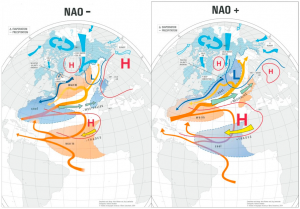North Atlantic Oscillation (NAO)
NAO is hemispheric meridional oscillation in atmospheric mass with centers of action near Iceland and over the subtropical Atlantic. It has two phases: positive and negative.
The positive phase of the NAO reflects below-normal heights and pressure across the high latitudes of the North Atlantic and above-normal heights and pressure over the central North Atlantic, the eastern United States and western Europe.
Winds from the west dominate, bringing with them warm air, while the position of the jet stream enables stronger and more frequent storms to travel across the Atlantic
These support mild, stormy and wet winter conditions in northern Europe and eastern US. Conversely, northern Canada, Greenland and southern Europe are prone to cold and dry winter conditions.
The negative phase reflects an opposite pattern of height and pressure anomalies over these regions, which results in changes in temperature and precipitation patterns often extending from eastern North America to western and central Europe.
Winds from the east and north-east are more frequent, bringing with them cold air, while the adjusted position of the jet stream leads to weaker and less frequent storms.
As a result, Europe and eastern US are more likely to experience cold, calm and dry winters. In contrast, northern Canada and Greenland will tend to be mild and wet.



 This project (EDU-ARCTIC) has received funding from the European Union’s Horizon 2020 research and innovation programme under grant agreement No 710240. The content of the website is the sole responsibility of the Consortium and it does not represent the opinion of the European Commission, and the Commission is not responsible for any use that might be made of information contained.
This project (EDU-ARCTIC) has received funding from the European Union’s Horizon 2020 research and innovation programme under grant agreement No 710240. The content of the website is the sole responsibility of the Consortium and it does not represent the opinion of the European Commission, and the Commission is not responsible for any use that might be made of information contained.